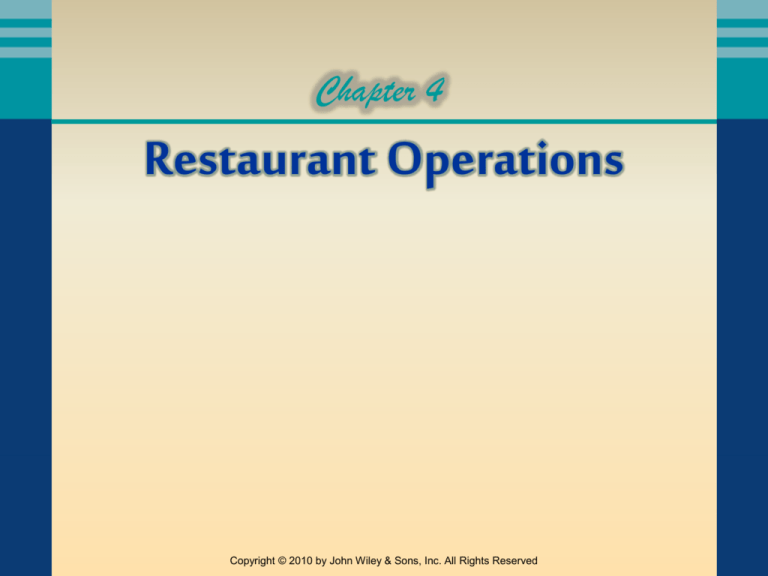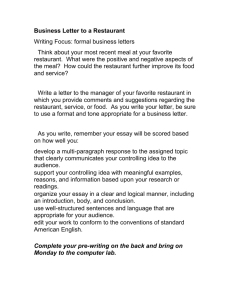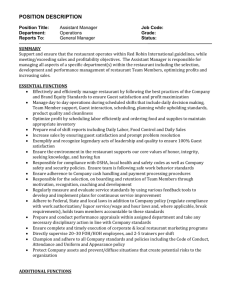
Chapter 4
Restaurant Operations
Copyright © 2010 by John Wiley & Sons, Inc. All Rights Reserved
RESTAURANT OPERATIONS
• This module looks more closely at the actual
operations of a restaurant
• This module should reinforce the notion that to
understand the restaurant business, one must
not only study it but also work in it
• Even though there are many different types of
restaurants, much of the actual work that is
performed in them is common across segments
RESTAURANT OPERATIONS
• The typical restaurant can be divided into three
general areas: (1) the front-of-the-house; (2)
the back-of-the-house and; (3) the office
• The front-of-the-house is where the customer
is serviced; the back-of-the-house is where the
food is produced/prepared and; the office is
where much of the planning and management
takes place
THE FRONT-OF-THE-HOUSE
• The front-of-the-house is the part of the
restaurants with which most of us are familiar
because it is the most visible
• It is where the customer and service staff come
together—as a result it is referred to as the
“marketplace” portion of the restaurant
• It goes beyond this however; the front-of-thehouse encompasses an operating system, a
business place, and a social setting
THE FRONT-OF-THE-HOUSE
• The primary responsibility of the front-of-thehouse is assuring guest satisfaction
• This comes down to several factors including:
•
•
•
•
•
•
offering a quality product
knowing what the guest wants
having a properly planned service system
having a properly trained staff
empowering staff to make decisions
taking care of problems when they arise
THE FRONT-OF-THE-HOUSE
• Remember that errors will happen but what
matters is how (and how quickly) they are
corrected
• Managers should also be present in the frontof-the-house, not just to supervise staff, but to
assist them in performing their jobs, to monitor
sales control, and to interact with guests
• It is critical for all food service managers to
have an understanding of the organization of
the front-of-the-house
THE FRONT-OF-THE-HOUSE
• FOH servers are also responsible for coordinating efforts
with the BOH in placing accurate orders, picking them up in
a timely manner and, in some cases, preparing some food
and beverage products (salads, desserts and drinks)
• Other responsibilities of FOH staff include maintaining
control of sales including cash, checks and credit card sales
• POS systems have simplified systems, provide greater
control and have created a higher degree of efficiency
THE FRONT-OF-THE-HOUSE
• Specific tasks include:
•
•
•
•
•
•
•
Greeting the guest
Taking the order
Serving the food (and beverages)
Checking with the table
Removing used tableware
Accepting payment
Thanking the guest (last opportunity for internal
promotion)
THE FRONT-OF-THE-HOUSE
• Roles and positions for various FOH staff
include:
•
•
•
•
•
Hosts/Hostesses
Counter person
Servers
Cashier
Bussers
THE FRONT-OF-THE-HOUSE
• Supervision entails the
direct presence of
management in the FOH. It
is important for the
employees and customers
alike
• Sometimes, depending on
the company, supervision
responsibilities are
combined for the FOH and
BOH
THE BACK-OF-THE-HOUSE
• To take a production analogy, the back-of-thehouse can be likened to a factory
• Some restaurant kitchens prepare everything
from scratch, some prepare a few items from
scratch, and others simply assemble preprepared foods that may have been prepared
several hundred miles away
• The primary responsibility of the BOH is to
prepare “quality” food
THE BACK-OF-THE-HOUSE
• Various BOH tasks include:
•
•
•
•
•
•
•
Purchasing and receiving
Food “prep”
Food production
Portion control
Quality control
Safety and sanitation
Dishwashing, etc.
MANAGEMENT
• What is a manager?
• What does a manager do?
• Some thoughts:
– Someone who is “in charge”
– Someone who assigns tasks
– Someone who supports employees
– Someone who opens and closes the restaurant
– Someone who looks after the financial concerns
MANAGEMENT
• Different operations use different titles
– General manager
– Unit manager
– Assistant manager
– Manager on duty
• Responsibilities will differ as well
• In all forms, there is a hierarchy
FINANCIAL CONSIDERATIONS
• Making a profit can be a very challenging
objective
• The average restaurant makes about 4% on the
dollar
• Managers must be adept at increasing sales
(revenue management) and controlling (or
reducing) costs
FINANCIAL CONSIDERATIONS
• Operating ratios used on a daily basis:
• Expense ratios usually focus on variable costs:
– Food cost
– Beverage cost
– Labor cost
• Sales/customer statistics commonly used
include:
– Number of covers
– Average check
THE LIFE OF A MANAGER IN THE
RESTAURANT INDUSTRY
• Consider:
•
•
•
•
•
Weekend, holiday and evening work
Long work weeks
Staying until the work is complete
Salary levels (median in 2008 was just over $46,000)
Wide range of responsibilities




